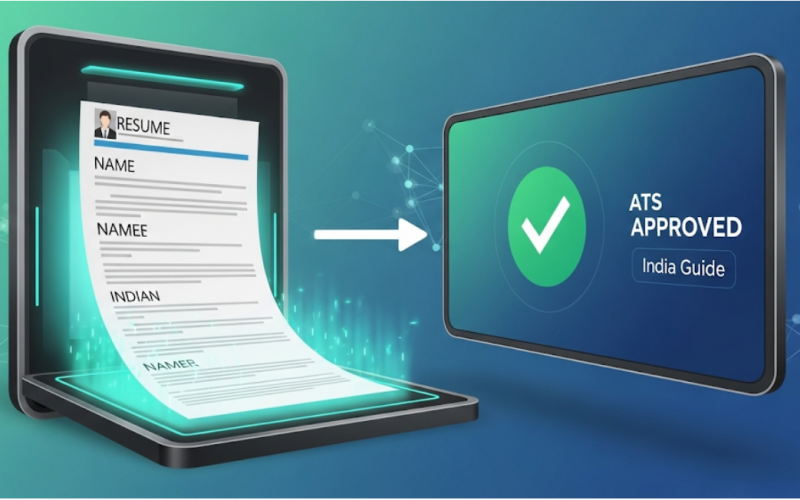ATS-Friendly Resume Guide for India: Get Past Applicant Tracking Systems in 2025

Create ATS-compliant resumes that beat automated screening. Complete guide with templates, keywords, and formatting tips for Indian job seekers.
Applicant Tracking Systems (ATS) now filter 75% of resumes in India before human recruiters see them. Understanding how to create ATS-friendly resumes is crucial for job seekers using Jobsfiy to maximize their chances of landing interviews with top companies.
Understanding ATS Technology
ATS software scans resumes for specific keywords, qualifications, and formatting elements that match job requirements. These systems extract information including contact details, work experience, education, and skills, then rank applications based on relevance to the role.
How ATS Systems Work in Indian Companies
Major Indian corporations and multinational companies operating in India extensively use ATS platforms. The system creates an ideal candidate profile based on job descriptions, then compares each resume against this benchmark. Only top-ranking resumes pass to human reviewers.
Essential ATS Resume Components
File Format Optimization
Submit resumes as .doc, .docx, or .txt files. Avoid PDFs unless specifically requested, as many ATS systems cannot properly read PDF formats.
Keyword Optimization Strategy
Use exact terminology from job postings rather than synonyms:
"Project Management" instead of "Leading Projects"
"Customer Relationship Management (CRM)" instead of "Managing Client Interactions"
"Data Analysis" instead of "Analyzing Information"
"Budget Management" instead of "Handling Finances"
Standard Resume Structure
Include these sections in order:
Resume Header (name and contact information)
Professional Summary/Objective
Work Experience (reverse chronological)
Skills Section
Education
Certifications (if relevant)
ATS-Compliant Formatting Guidelines
Font and Design Choices
Use standard fonts like Arial, Helvetica, Times New Roman, or Calibri. Maintain 10-12 point font size with consistent formatting throughout. Avoid decorative fonts, graphics, images, or complex designs that confuse ATS parsing.
Section Headers and Organization
Use standard section headers like "Work Experience," "Education," "Skills" rather than creative alternatives. Maintain clear hierarchy with proper heading structures (H1, H2) and consistent spacing.
Contact Information Placement
Place contact details in the header section with standard formatting:
Full Name
Phone Number
Email Address
LinkedIn Profile URL
City, State (avoid full addresses)
Work Experience Optimization
Job Title and Company Format
List job titles prominently, followed by company names and employment dates. Use standard date formats (MM/YYYY) and include employment duration.
Achievement-Focused Descriptions
Write bullet points that combine keywords with quantified achievements:
"Managed software development team of 8 developers, delivering 15+ projects using Agile methodology"
"Increased sales revenue by 25% through digital marketing campaigns and customer relationship management"
Indian Market-Specific ATS Tips
Include Relevant Indian Qualifications
List Indian educational institutions, professional certifications (CA, CS, CWA), and local industry certifications that ATS systems in India recognize.
Location-Based Keywords
Include city names, regional preferences, and location-specific terms that match job postings. Many Indian companies search for candidates in specific cities or regions.
Industry-Specific Terminology
Use sector-appropriate language:
IT: Include programming languages, frameworks, methodologies
Finance: Mention regulations, compliance standards, financial instruments
Manufacturing: Reference quality standards, safety protocols, operational processes
Common ATS Mistakes to Avoid
Never use tables, columns, or complex formatting that disrupts text parsing. Avoid headers/footers for important information, images or graphics, abbreviations without full forms, and creative section names that ATS doesn't recognize.
Testing Your Resume for ATS Compatibility
Copy your resume text into a plain text (.txt) file to check if formatting remains readable. Use online ATS scanner tools to test keyword optimization and ensure all information appears correctly when parsed.
Industry-Specific Keyword Strategies
Technology Sector
Include programming languages, software tools, frameworks, methodologies (Agile, DevOps), cloud platforms, and database management systems.
Finance and Banking
Incorporate financial regulations, compliance standards, risk management, financial modeling, and industry-specific software knowledge.
Healthcare
Mention medical certifications, healthcare systems, patient management software, regulatory compliance, and clinical procedures.
Advanced ATS Optimization Techniques
Skills Section Strategy
Create a dedicated skills section with both hard and soft skills mentioned in job descriptions. Include technical proficiencies, industry knowledge, language skills, and certification details.
Education Section Enhancement
List degrees with full institution names, graduation dates, relevant coursework, academic achievements, and professional development activities.
Quantified Impact Statements
Transform generic descriptions into achievement-focused statements with specific numbers, percentages, timelines, and measurable outcomes.
Modern ATS Considerations
Latest ATS systems are becoming more sophisticated, recognizing context and semantic relationships. However, maintaining proper formatting and keyword optimization remains crucial for success in Indian job markets.
Creating Multiple Resume Versions
Develop tailored versions for different roles, industries, and experience levels. Maintain core structure while adjusting keywords, emphasizing relevant experience, and modifying skill highlights based on specific job requirements.
By following these ATS optimization strategies, job seekers using Jobsfiy can significantly improve their resume's visibility and increase interview callbacks from top Indian employers using applicant tracking systems.
- Share This Job












Write A Comment
No Comments